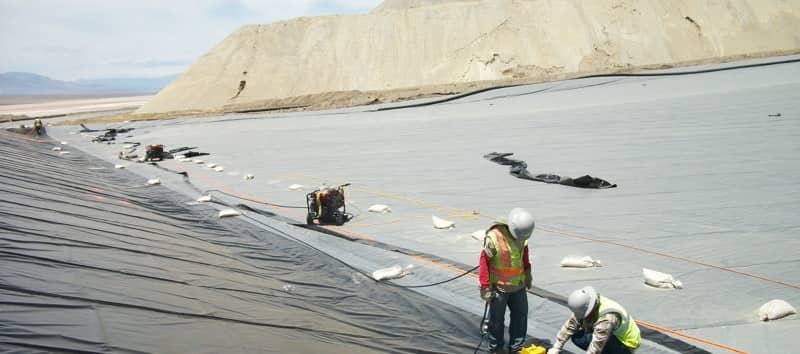 Geomembranes are either coated or laminated during the manufacturing process. A coated geomembrane relies on an adhesive coat to bond the exterior coating to the base cloth, whereas, a laminate is dependent on strike-through adhesion of the film to itself and minimal adhesion to the yarn. The combination of the base cloth to the coating/film is important in order to make a long-term durable geomembrane. The result of a highly engineering geomembrane will increase the performance factors below:
Geomembranes are either coated or laminated during the manufacturing process. A coated geomembrane relies on an adhesive coat to bond the exterior coating to the base cloth, whereas, a laminate is dependent on strike-through adhesion of the film to itself and minimal adhesion to the yarn. The combination of the base cloth to the coating/film is important in order to make a long-term durable geomembrane. The result of a highly engineering geomembrane will increase the performance factors below:
- Waterproofness
- Chemical Resistance
- UV Resistance
- Abrasion Resistance
- Antimicrobial Properties
Coated and laminated geomembranes are readily available in the geo market. So which is the better option? That answer predominantly depends upon your specific application. We’ve provided a comparison below to help you get started.
Adhesion
Adhesion is incredibly important and impacts a number of other performance factors. With coated geomembranes, the adhesive saturates the base cloth of the geomembrane, increasing the adhesion of the exterior coating to the base cloth. This is referred to as a chemical adhesion. It also allows for some strike-through adhesion.
Laminates, on the other hand, utilize an open base cloth and rely heavily on strike through of the film between the base cloth for adhesion. This represents mechanical adhesion. It allows for the cloth to move within the matrix which can make the geomembrane highly susceptible to tunneling (lifting of film over the yarn area). When a laminated geomembrane is flexed, it weakens what little bond there is between the film and yarn, resulting in lower adhesion.
Dead Load
Dead load refers to a membrane’s ability to carry a certain amount of load across its seams. The yarn gives the geomembrane its strength, while the coating/film is in place to protect the yarn. With laminated geomembranes, the yarn will slip out of the seamed area under load resulting in the strength of the film to maintain the integrity of the geomembrane. This is due to the lack of adhesion to the yarns. The film under load without the yarn will stretch and thin. Because of this, your 60 mil laminate is now only giving you the protection you would see with 40 mil of the same product.
Coated geomembranes have increased dead load characteristics due to the adhesive coat. This allows the installer to consider placement of cross-seams on slopes without concern of the yarn sliding out of the seamed area. Even in exposed environments, the integrity of the seam on coated geomembranes with an adhesive coat will not be jeopardized. They are also much more flexible in terms of application - these membranes can get poked and prodded without failing prematurely (other factors notwithstanding, i.e. installation). Coated geomembranes can also be folded and bunched.
Anti-Wicking
If you install a geomembrane that has a high propensity to wick, you could be setting yourself up for premature failure. This is especially true in instances where your geomembrane will be exposed to effluents. On laminates, once the effluent wicks up into the yarn it will inhibit the cohesion of the film to the base cloth. Swelling might also occur depending on what is being transferred through the yarn. To alleviate the phenomena, laminates can be manufactured with anti-wicking yarns which may create other issues. Coated geomembranes are anti-wicking as the adhesive coat saturates and protects the yarn. This ensures the effluent will not penetrate the coating matrix jeopardizing the performance of the coated geomembrane.
What other performance factors do you take into consideration before choosing a product? Tell us about it in the comments.




